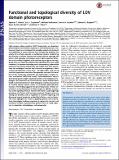Functional and topological diversity of LOV domain photoreceptors
Author(s)
Glantz, Spencer T.; Carpenter, Eric J.; Melkonian, Michael; Gardner, Kevin H.; Wong, Gane Ka-Shu; Chow, Brian Y.; Boyden, Edward; ... Show more Show less
DownloadGlantz-2016-Functional and topol.pdf (7.164Mb)
PUBLISHER_POLICY
Publisher Policy
Article is made available in accordance with the publisher's policy and may be subject to US copyright law. Please refer to the publisher's site for terms of use.
Terms of use
Metadata
Show full item recordAbstract
Light–oxygen–voltage sensitive (LOV) flavoproteins are ubiquitous photoreceptors that mediate responses to environmental cues. Photosensory inputs are transduced into signaling outputs via structural rearrangements in sensor domains that consequently modulate the activity of an effector domain or multidomain clusters. Establishing the diversity in effector function and sensor–effector topology will inform what signaling mechanisms govern light-responsive behaviors across multiple kingdoms of life and how these signals are transduced. Here, we report the bioinformatics identification of over 6,700 candidate LOV domains (including over 4,000 previously unidentified sequences from plants and protists), and insights from their annotations for ontological function and structural arrangements. Motif analysis identified the sensors from ∼42 million ORFs, with strong statistical separation from other flavoproteins and non-LOV members of the structurally related Per-aryl hydrocarbon receptor nuclear translocator (ARNT)-Sim family. Conserved-domain analysis determined putative light-regulated function and multidomain topologies. We found that for certain effectors, sensor–effector linker length is discretized based on both phylogeny and the preservation of α-helical heptad repeats within an extended coiled-coil linker structure. This finding suggests that preserving sensor–effector orientation is a key determinant of linker length, in addition to ancestry, in LOV signaling structure–function. We found a surprisingly high prevalence of effectors with functions previously thought to be rare among LOV proteins, such as regulators of G protein signaling, and discovered several previously unidentified effectors, such as lipases. This work highlights the value of applying genomic and transcriptomic technologies to diverse organisms to capture the structural and functional variation in photosensory proteins that are vastly important in adaptation, photobiology, and optogenetics.
Date issued
2016-02Department
Massachusetts Institute of Technology. Department of Biological Engineering; Massachusetts Institute of Technology. Department of Brain and Cognitive Sciences; Massachusetts Institute of Technology. Media Laboratory; McGovern Institute for Brain Research at MIT; Program in Media Arts and Sciences (Massachusetts Institute of Technology)Journal
Proceedings of the National Academy of Sciences
Publisher
National Academy of Sciences (U.S.)
Citation
Glantz, Spencer T. et al. “Functional and Topological Diversity of LOV Domain Photoreceptors.” Proceedings of the National Academy of Sciences 113.11 (2016): E1442–E1451. © 2016 National Academy of Sciences
Version: Final published version
ISSN
0027-8424
1091-6490